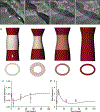Spontaneous reversal of stenosis in tissue-engineered vascular grafts
- PMID: 32238576
- PMCID: PMC7478265
- DOI: 10.1126/scitranslmed.aax6919
Spontaneous reversal of stenosis in tissue-engineered vascular grafts
Abstract
We developed a tissue-engineered vascular graft (TEVG) for use in children and present results of a U.S. Food and Drug Administration (FDA)-approved clinical trial evaluating this graft in patients with single-ventricle cardiac anomalies. The TEVG was used as a Fontan conduit to connect the inferior vena cava and pulmonary artery, but a high incidence of graft narrowing manifested within the first 6 months, which was treated successfully with angioplasty. To elucidate mechanisms underlying this early stenosis, we used a data-informed, computational model to perform in silico parametric studies of TEVG development. The simulations predicted early stenosis as observed in our clinical trial but suggested further that such narrowing could reverse spontaneously through an inflammation-driven, mechano-mediated mechanism. We tested this unexpected, model-generated hypothesis by implanting TEVGs in an ovine inferior vena cava interposition graft model, which confirmed the prediction that TEVG stenosis resolved spontaneously and was typically well tolerated. These findings have important implications for our translational research because they suggest that angioplasty may be safely avoided in patients with asymptomatic early stenosis, although there will remain a need for appropriate medical monitoring. The simulations further predicted that the degree of reversible narrowing can be mitigated by altering the scaffold design to attenuate early inflammation and increase mechano-sensing by the synthetic cells, thus suggesting a new paradigm for optimizing next-generation TEVGs. We submit that there is considerable translational advantage to combined computational-experimental studies when designing cutting-edge technologies and their clinical management.
Copyright © 2020 The Authors, some rights reserved; exclusive licensee American Association for the Advancement of Science. No claim to original U.S. Government Works.
Figures







References
-
- van der Linde D, Konings EEM, Slager MA, Witsenburg M, Helbing WA, Takkenberg JJM, Roos-Hesselink JW, Birth prevalence of congenital heart disease worldwide: A systematic review and meta-analysis. J. Am. Coll. Cardiol. 58, 2241–2247 (2011). - PubMed
-
- Shinoka T, What is the best material for extracardiac Fontan operation. J. Thorac. Cardiovasc. Surg. 153, 1551–1552 (2017). - PubMed
-
- Alexi-Meskishvili V, Ovroutski S, Ewert P, Dähnert I, Berger F, Lange PE, Hetzer R, Optimal conduit size for extracardiac Fontan operation. Eur. J. Cardiothorac. Surg. 18, 690–695 (2000). - PubMed
Publication types
MeSH terms
Grants and funding
- R01 HL098228/HL/NHLBI NIH HHS/United States
- TL1 TR001069/TR/NCATS NIH HHS/United States
- R01 HL139796/HL/NHLBI NIH HHS/United States
- T32 HL098039/HL/NHLBI NIH HHS/United States
- T32 AI106704/AI/NIAID NIH HHS/United States
- T32 GM068412/GM/NIGMS NIH HHS/United States
- R01 HL128602/HL/NHLBI NIH HHS/United States
- K99 HL139996/HL/NHLBI NIH HHS/United States
- UL1 TR001863/TR/NCATS NIH HHS/United States
- TL1 TR002735/TR/NCATS NIH HHS/United States
- R01 HL128847/HL/NHLBI NIH HHS/United States
- R00 HL139996/HL/NHLBI NIH HHS/United States
LinkOut - more resources
Full Text Sources
Medical

